Construction of Hollow Co3O4@ZnIn2S4 p-n Heterojunctions for Highly Efficient Photocatalytic Hydrogen Production
Abstract
1. Introduction
2. Experimental Section
2.1. Chemicals and Materials
2.2. Synthesis of ZIF-67
2.3. Synthesis of Co3O4
2.4. Synthesis of ZnIn2S4@Co3O4
2.5. Characterization
2.6. Photocatalytic Activities Test
2.7. Catalyst Photoelectric Performance Test
3. Results and Discussion
4. Conclusions
Supplementary Materials
Author Contributions
Funding
Conflicts of Interest
References
- Wang, X.; Zhao, Y.; Mølhave, K.; Sun, H. Engineering the Surface/Interface Structures of Titanium Dioxide Micro and Nano Architectures towards Environmental and Electrochemical Applications. Nanomaterials 2017, 7, 382. [Google Scholar] [CrossRef] [PubMed]
- Yadav, A.A.; Hunge, Y.M.; Kang, S.-W. Visible Light-Responsive CeO2/MoS2 Composite for Photocatalytic Hydrogen Production. Catalysts 2022, 12, 1185. [Google Scholar] [CrossRef]
- Hunge, Y.M.; Yadav, A.A.; Kang, S.-W.; Lim, S.J.; Kim, H. Visible light activated MoS2/ZnO composites for photocatalytic degradation of ciprofloxacin antibiotic and hydrogen production. J. Photochem. Photobiol. A Chem. 2023, 434, 114250. [Google Scholar] [CrossRef]
- Hunge, Y.M.; Yadav, A.A.; Kang, S.W.; Kim, H. Facile synthesis of multitasking composite of Silver nanoparticle with Zinc oxide for 4-nitrophenol reduction, photocatalytic hydrogen production, and 4-chlorophenol degradatio. J. Alloys Compd. 2022, 928, 167133. [Google Scholar] [CrossRef]
- Yadav, A.A.; Hunge, Y.M.; Kang, S.W. Spongy ball-like copper oxide nanostructure modified by reduced graphene oxide for enhanced photocatalytic hydrogen production. Mater. Res. Bull. 2021, 133, 111026. [Google Scholar] [CrossRef]
- Wang, Z.; Li, C.; Domen, K. Recent developments in heterogeneous photocatalysts for solar-driven overall water splitting. Chem. Soc. Rev. 2019, 48, 2109–2125. [Google Scholar] [CrossRef]
- Yuan, Y.-J.; Chen, D.; Yu, Z.-T.; Zou, Z.-G. Cadmium sulfide-based nanomaterials for photocatalytic hydrogen production. J. Mater. Chem. A 2018, 6, 11606–11630. [Google Scholar] [CrossRef]
- Fujishima, A.; Honda, K. Electrochemical Photolysis of Water at a Semiconductor Electrode. Nature 1972, 238, 37–38. [Google Scholar] [CrossRef]
- Xie, M.; Dai, X.; Meng, S.; Fu, X.; Chen, S. Selective oxidation of aromatic alcohols to corresponding aromatic aldehydes using In2S3 microsphere catalyst under visible light irradiation. Chem. Eng. J. 2014, 245, 107–116. [Google Scholar] [CrossRef]
- Poudel, M.B.; Lohani, P.C.; Kim, A.A. Synthesis of silver nanoparticles decorated tungsten oxide nanorods as high-performance supercapacitor electrode. Chem. Phys. Lett. 2022, 804, 139884. [Google Scholar] [CrossRef]
- Poudel, M.B.; Kim, A.R.; Ramakrishan, S. Integrating the essence of metal organic framework-derived ZnCoTe–N–C/MoS2 cathode and ZnCo-NPS-N-CNT as anode for high-energy density hybrid supercapacitors. Compos. Part B-Eng. 2022, 247, 110339. [Google Scholar] [CrossRef]
- Shi, Y.; Xiong, X.; Ding, S.; Liu, X.; Jiang, Q.; Hu, J. In-Situ topotactic synthesis and photocatalytic activity of plate-like BiOCl/2D networks Bi2S3 heterostructures. Appl. Catal. B-Environ. 2018, 220, 570–580. [Google Scholar] [CrossRef]
- Xiong, X.; Zhou, T.; Liu, X.; Ding, S.; Hu, J. Surfactant-mediated synthesis of single-crystalline Bi3O4Br nanorings with enhanced photocatalytic activity. J. Mater. Chem. A 2017, 5, 15706–15713. [Google Scholar] [CrossRef]
- Dong, J.; Zhang, Y.; Hussain, M.I.; Zhou, W.; Chen, Y.; Wang, L.-N. g-C3N4: Properties, Pore Modifications, and Photocatalytic Applications. Nanomaterials 2022, 12, 121. [Google Scholar] [CrossRef]
- Zhang, E.; Zhu, Q.; Huang, J.; Liu, J.; Tan, G.; Sun, C.; Li, T.; Liu, S.; Li, Y.; Wang, H.; et al. Visually resolving the direct Z-scheme heterojunction in CdS@ZnIn2S4 hollow cubes for photocatalytic evolution of H2 and H2O2 from pure water. Appl. Catal. B-Environ. 2021, 293, 120213. [Google Scholar] [CrossRef]
- Tang, B.; Yu, Z.G.; Zhang, Y.; Tang, C.; Seng, H.L.; Seh, Z.W.; Zhang, Y.-W.; Pennycook, S.J.; Gong, H.; Yang, W. Metal–organic framework-derived hierarchical MoS2/CoS2 nanotube arrays as pH-universal electrocatalysts for efficient hydrogen evolution. J. Mater. Chem. A 2019, 7, 13339–13346. [Google Scholar] [CrossRef]
- Peng, X.; Ye, L.; Ding, Y.; Yi, L.; Zhang, C.; Wen, Z. Nanohybrid photocatalysts with ZnIn2S4 nanosheets encapsulated UiO-66 octahedral nanoparticles for visible-light-driven hydrogen generation. Appl. Catal. B-Environ. 2020, 260, 118152. [Google Scholar] [CrossRef]
- Liu, H.; Zhang, J.; Ao, D. Construction of heterostructured ZnIn2S4@NH2-MIL-125(Ti) nanocomposites for visible-light-driven H2 production. Appl. Catal. B-Environ. 2018, 221, 433–442. [Google Scholar] [CrossRef]
- Li, Y.; Hou, Y.; Fu, Q.; Peng, S.; Hu, Y.H. Oriented growth of ZnIn2S4/In(OH)3 heterojunction by a facile hydrothermal transformation for efficient photocatalytic H2 production. Appl. Catal. B-Environ. 2017, 206, 726–733. [Google Scholar] [CrossRef]
- Zuo, G.; Wang, Y.; Teo, W.L.; Xie, A.; Guo, Y.; Dai, Y.; Zhou, W.; Jana, D.; Xian, Q.; Dong, W.; et al. Ultrathin ZnIn2S4 Nanosheets Anchored on Ti3C2TX MXene for Photocatalytic H2 Evolution. Angew. Chem. Int. Ed. 2020, 59, 11287–11292. [Google Scholar] [CrossRef] [PubMed]
- Wang, L.; Tang, G.; Liu, S.; Dong, H.; Liu, Q.; Sun, J.; Tang, H. Interfacial active-site-rich 0D Co3O4/1D TiO2 p-n heterojunction for enhanced photocatalytic hydrogen evolution. Chem. Eng. J. 2022, 428, 131338. [Google Scholar] [CrossRef]
- Liu, D.; Chen, D.; Li, N.; Xu, Q.; Li, H.; He, J.; Lu, J. ZIF-67-Derived 3D Hollow Mesoporous Crystalline Co3O4 Wrapped by 2D g-C3N4 Nanosheets for Photocatalytic Removal of Nitric Oxide. Small 2019, 15, 1902291. [Google Scholar] [CrossRef] [PubMed]
- Lai, X.; Li, J.; Korgel, B.A.; Dong, Z.; Li, Z.; Su, F.; Du, J.; Wang, D. General Synthesis and Gas-Sensing Properties of Multiple-Shell Metal Oxide Hollow Microspheres. Angew. Chem.-Int. Edit. 2011, 50, 2738–2741. [Google Scholar] [CrossRef] [PubMed]
- Sun, J.; Zhang, J.; Zhang, M.; Antonietti, M.; Fu, X.; Wang, X. Bioinspired hollow semiconductor nanospheres as photosynthetic nanoparticles. Nat. Commun. 2012, 3, 1139. [Google Scholar] [CrossRef]
- Xing, F.; Liu, Q.; Huang, C. Mo-Doped ZnIn2S4 Flower-Like Hollow Microspheres for Improved Visible Light-Driven Hydrogen Evolution. Sol. RRL 2020, 4, 1900483. [Google Scholar] [CrossRef]
- Chang, N.; Chen, Y.-R.; Xie, F.; Liu, Y.-P.; Wang, H.-T. A promising Z-scheme heterojunction via loading Ag/AgCl into porous Co3O4 derived from ZIF-67 for visible light driven photocatalysis. Microporous Mesoporous Mat. 2020, 307, 110530. [Google Scholar] [CrossRef]
- Zhang, X.; Ding, S.; Luo, X.; Huang, C.; Dong, T.; Yang, Y.; Liu, N.; Hu, J. Engineering amorphous red phosphorus onto ZnIn2S4 hollow microspheres with enhanced photocatalytic activity. Mater. Lett. 2018, 232, 78–81. [Google Scholar] [CrossRef]
- Zhang, G.; Chen, D.; Li, N.; Xu, Q.; Li, H.; He, J.; Lu, J. Construction of Hierarchical Hollow Co9S8/ZnIn2S4 Tubular Heterostructures for Highly Efficient Solar Energy Conversion and Environmental Remediation. Angew. Chem.-Int. Edit. 2020, 59, 8255–8261. [Google Scholar] [CrossRef]
- Syed, A.; Elgorban, A.M.; Bahkali, A.H.; Zaghloul, N.S.S. Coupling of nano-spinel MgFe2O4 on Co3O4 for heterogeneous photocatalysis and antibacterial applications: Insights of optoelectrical properties. Colloid Interface Sci. Commun. 2021, 44, 100467. [Google Scholar] [CrossRef]
- Dai, X.; Cui, L.; Yao, L.; Shi, L. Facile construction of novel Co3O4/Bi12O17Cl2 heterojunction composites with enhanced photocatalytic performance. J. Solid State Chem. 2021, 297, 122066. [Google Scholar] [CrossRef]
- Li, H.; Hao, X.; Gong, H.; Jin, Z.; Zhao, T. Efficient hydrogen production at a rationally designed MoSe2@Co3O4 p-n heterojunction. J. Solid State Chem. 2021, 586, 84–94. [Google Scholar] [CrossRef]
- Xu, X.; Wang, T.; Lu, W.; Dong, L.; Zhang, H.; Miao, X. Co x P@Co3O4 Nanocomposite on Cobalt Foam as Efficient Bifunctional Electrocatalysts for Hydrazine-Assisted Hydrogen Production. ACS Sustain. Chem. Eng. 2021, 9, 4688–4701. [Google Scholar] [CrossRef]
- Gao, Z.; Chen, K.; Wang, L.; Bai, B.; Liu, H.; Wang, Q. Aminated flower-like ZnIn2S4 coupled with benzoic acid modified g-C3N4 nanosheets via covalent bonds for ameliorated photocatalytic hydrogen generation. Appl. Catal. B-Environ. 2020, 268, 118462. [Google Scholar] [CrossRef]
- Zhang, Z.; Huang, L.; Zhang, J.; Wang, F.; Xie, Y.; Shang, X.; Gu, Y.; Zhao, H.; Wang, X. In Situ constructing interfacial contact MoS2/ZnIn2S4 heterostructure for enhancing solar photocatalytic hydrogen evolution. Appl. Catal. B-Environ. 2018, 233, 112–119. [Google Scholar] [CrossRef]
- Zhang, X.; Chen, Z.; Luo, Y.; Han, X.; Jiang, Q.; Zhou, T.; Yang, H.; Hu, J. Construction of NH2-MIL-125(Ti)/CdS Z-scheme heterojunction for efficient photocatalytic H2 evolution. J. Hazard. Mater. 2021, 405, 124128. [Google Scholar] [CrossRef] [PubMed]
- Chen, Z.; Pan, J.; Mei, J.; Yu, Q.; Wang, P.; Wang, P.; Wang, J.; Song, C.; Zheng, Y.; Li, C. Ternary Co3O4/CdS/SrTiO3 core-shell pn junctions toward enhanced photocatalytic hydrogen production activity. J. Environ. Chem. Eng. 2021, 9, 104895. [Google Scholar] [CrossRef]
- Jiang, H.; Xing, Z.; Zhao, T.; Yang, Z.; Wang, K.; Li, Z.; Yang, S.; Xie, L.; Zhou, W. Plasmon Ag nanoparticle/Bi2S3 ultrathin nanobelt/oxygen-doped flower-like MoS2 nanosphere ternary heterojunctions for promoting charge separation and enhancing solar-driven photothermal and photocatalytic performances. Appl. Catal. B-Environ. 2020, 274, 118947. [Google Scholar] [CrossRef]
- Poudel, M.B.; Ojha, G.P.; A kim, A.; Kim, H.J. Manganese-doped tungsten disulfide microcones as binder-free electrode for high performance asymmetric supercapacitor. J. Energy Storage 2022, 47, 103674. [Google Scholar] [CrossRef]
- Lin, B.; Li, H.; An, H.; Hao, W.; Wei, J.; Dai, Y.; Ma, C.; Yang, G. Preparation of 2D/2D g-C3N4 nanosheet@ZnIn2S4 nanoleaf heterojunctions with well-designed high-speed charge transfer nanochannels towards high-efficiency photocatalytic hy-drogen evolution. Appl. Catal. B Environ. 2018, 220, 542–552. [Google Scholar] [CrossRef]
- Gao, Y.; Lin, H.; Zhang, S.; Li, Z. Co(dmgH)2pyCl as a noble-metal-free co-catalyst for highly efficient photocatalytic hydrogen evolution over hexagonal ZnIn2S4. RSC Adv. 2016, 6, 6072–6076. [Google Scholar] [CrossRef]
- Li, Q.; Cui, C.; Meng, H.; Yu, J. Visible-light photocatalytic hydrogen production activity of ZnIn2S4 microspheres using carbon quantum dots and platinum as dual co-catalysts. Chem. Asian. J. 2014, 9, 1766–1770. [Google Scholar] [CrossRef] [PubMed]
- Huang, T.; Chen, W.; Liu, T.; Hao, Q.; Liu, X. Znln2S4 hybrid with MoS2: A non-noble metal photocatalyst with efficient photocatalytic activity for hydrogen evolution. Powder Technol. 2017, 315, 157–162. [Google Scholar] [CrossRef]
- Mei, Z.; Ouyang, S.; Tang, D.; Kako, T.; Golberg, D.; Ye, J. An ion-exchange route for the synthesis of hierarchical In2S3/ZnIn2S4 bulk composite and its photocatalytic activity under visible-light irradiation. Dalton Trans. 2013, 42, 2687–2690. [Google Scholar] [CrossRef] [PubMed]
- Chen, Y.; Tian, G.; Zhou, W.; Xiao, Y.; Wang, J.; Zhang, X.; Fu, H. Enhanced photo- generated carrier separation in CdS quantum dot sensitized ZnFe2O4/ZnIn2S4 nanosheet stereoscopic films for exceptional visible light photocatalytic H2 evo-lution performance. Nanoscale 2017, 9, 5912–5921. [Google Scholar] [CrossRef] [PubMed]

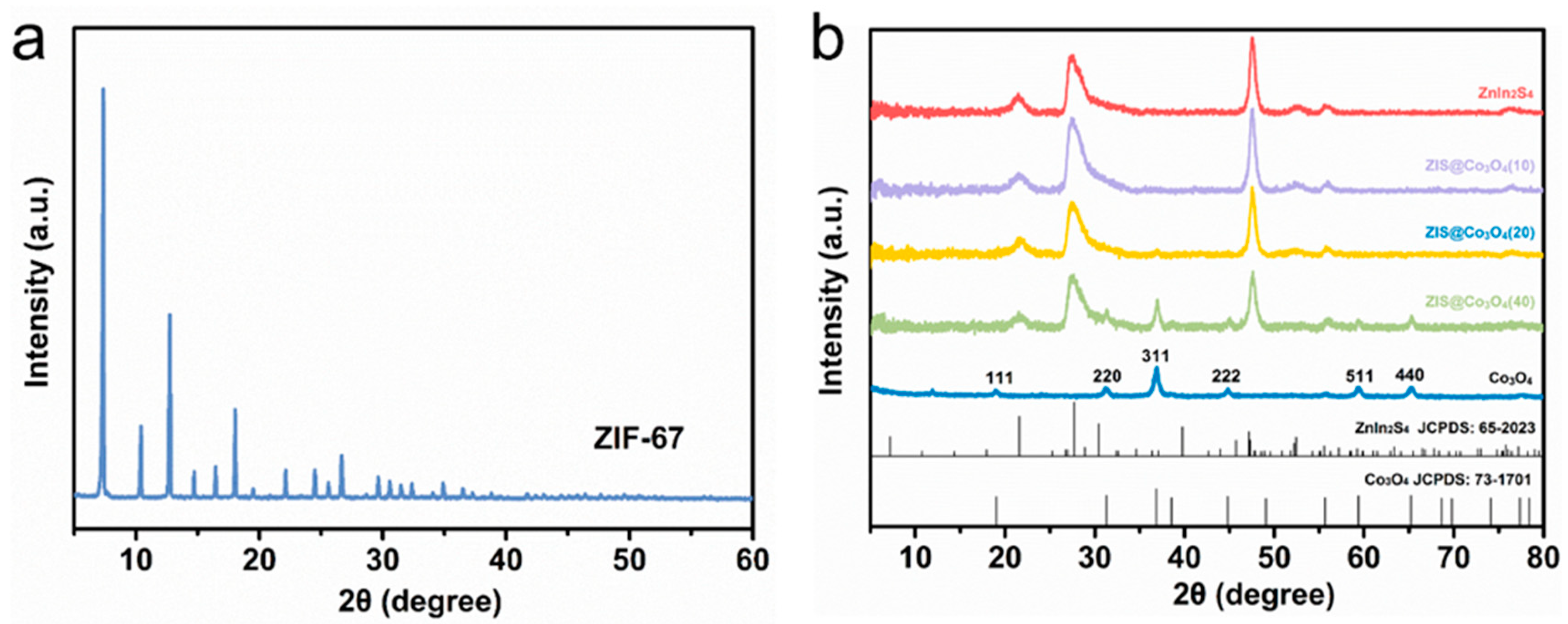


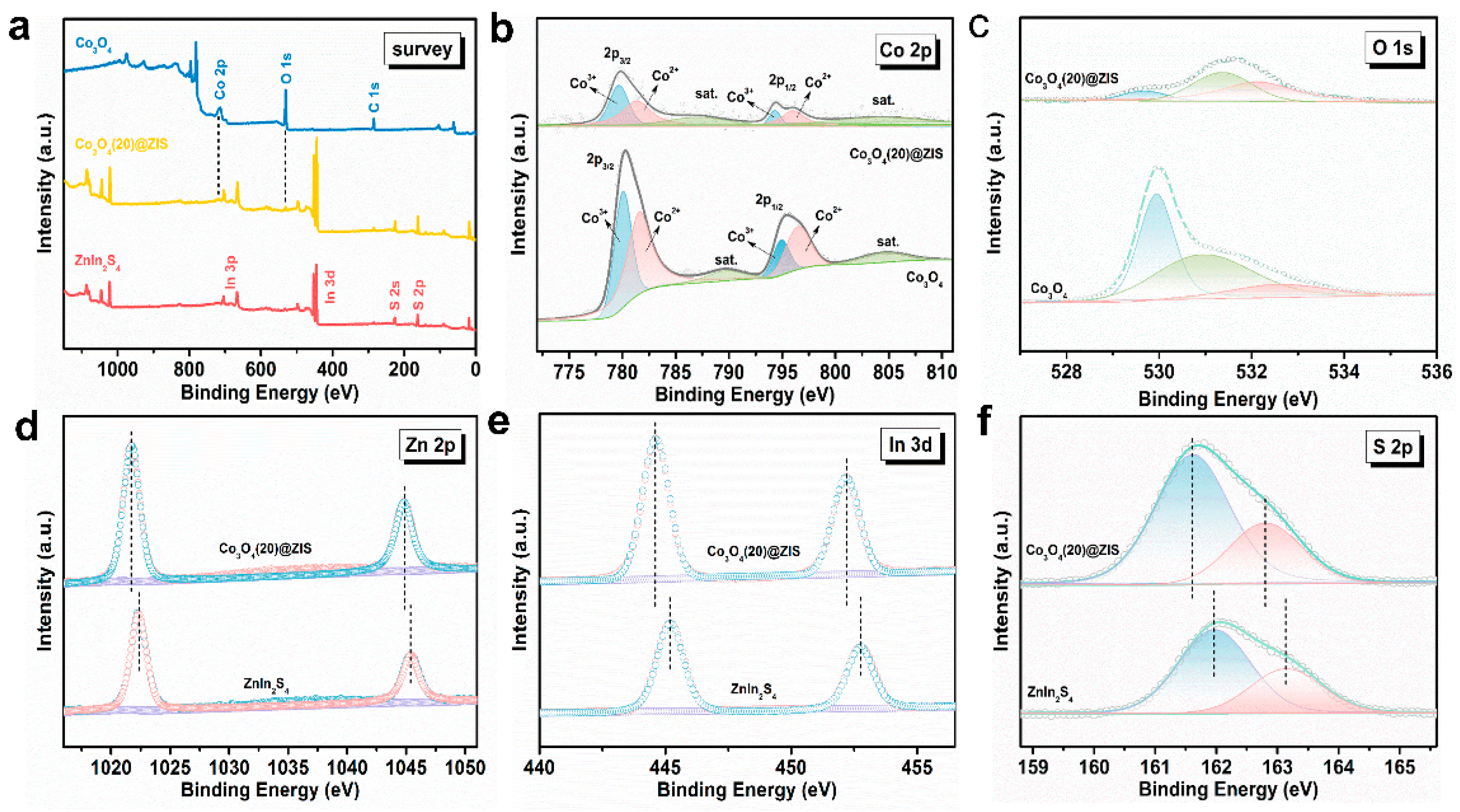
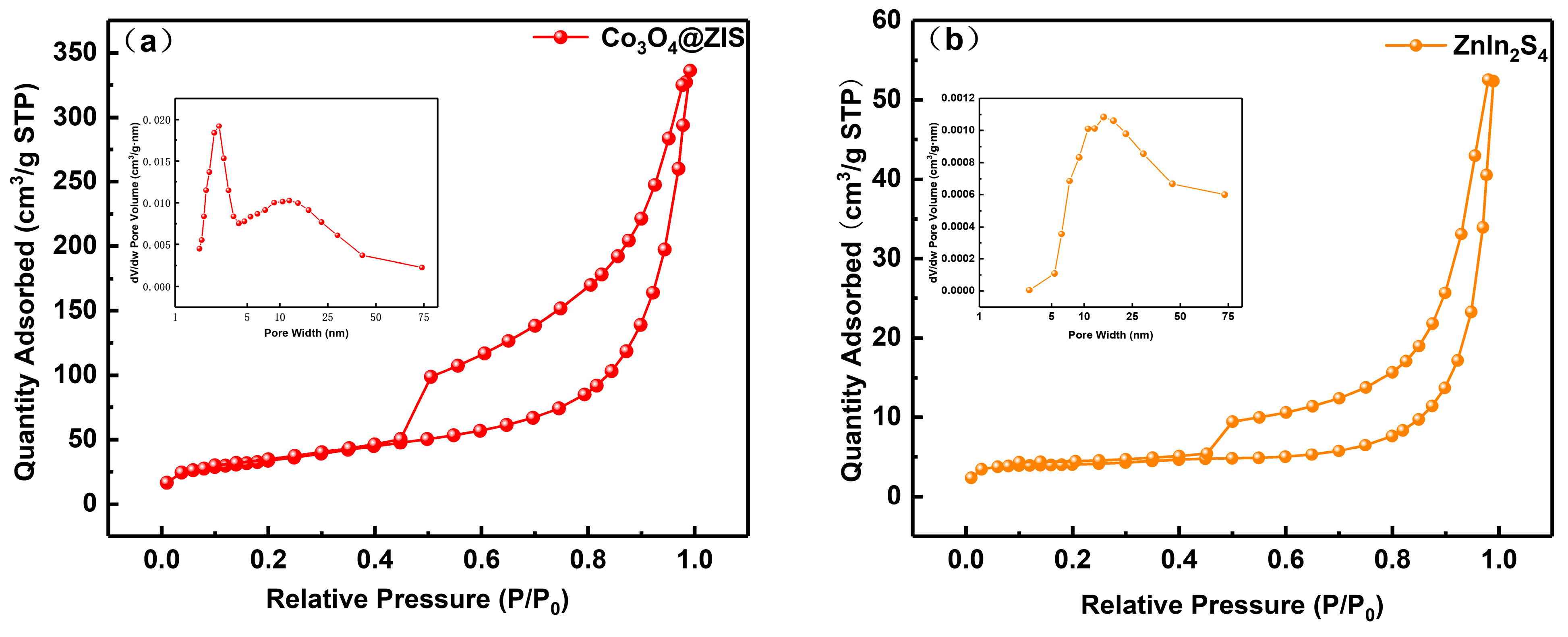
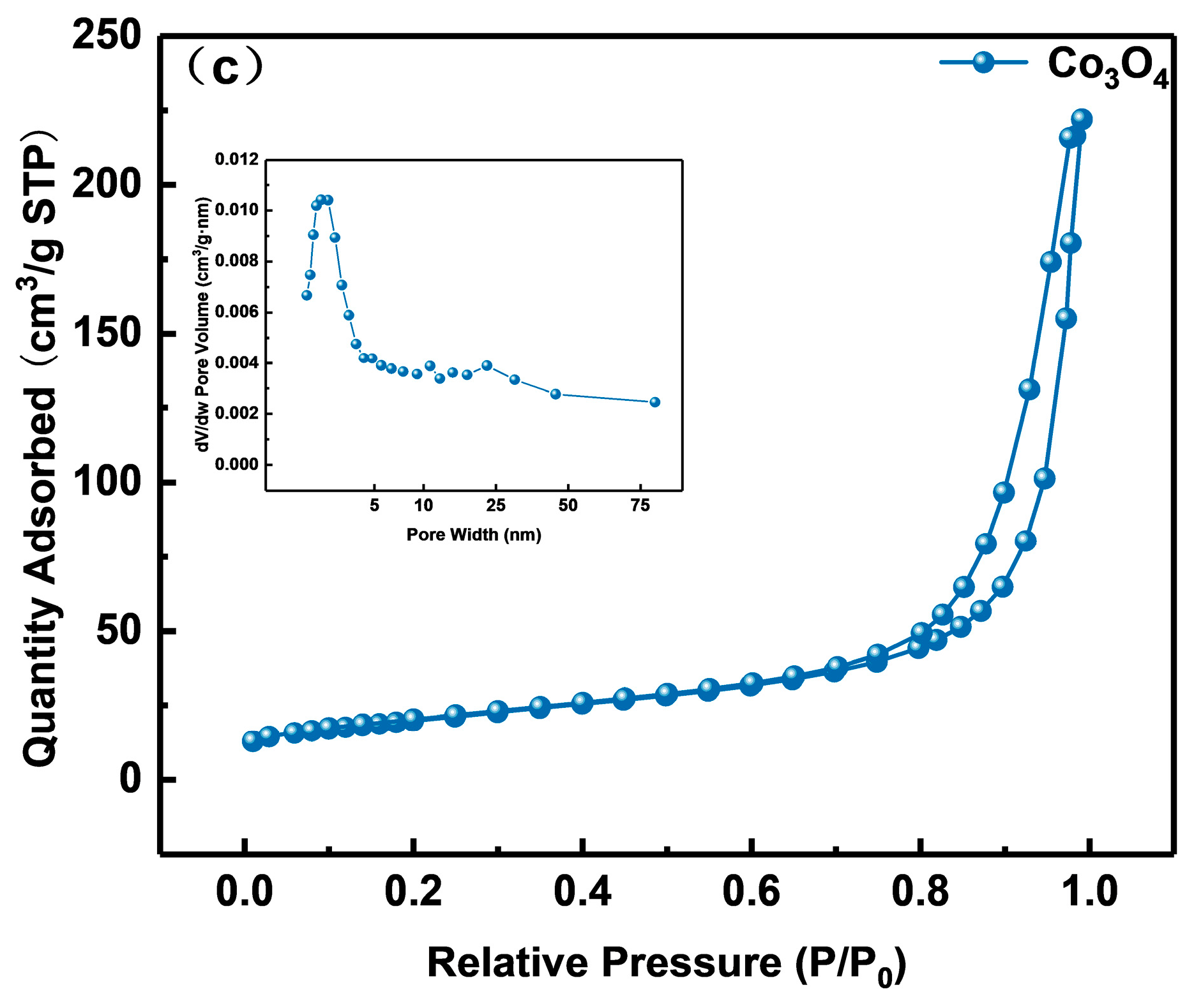

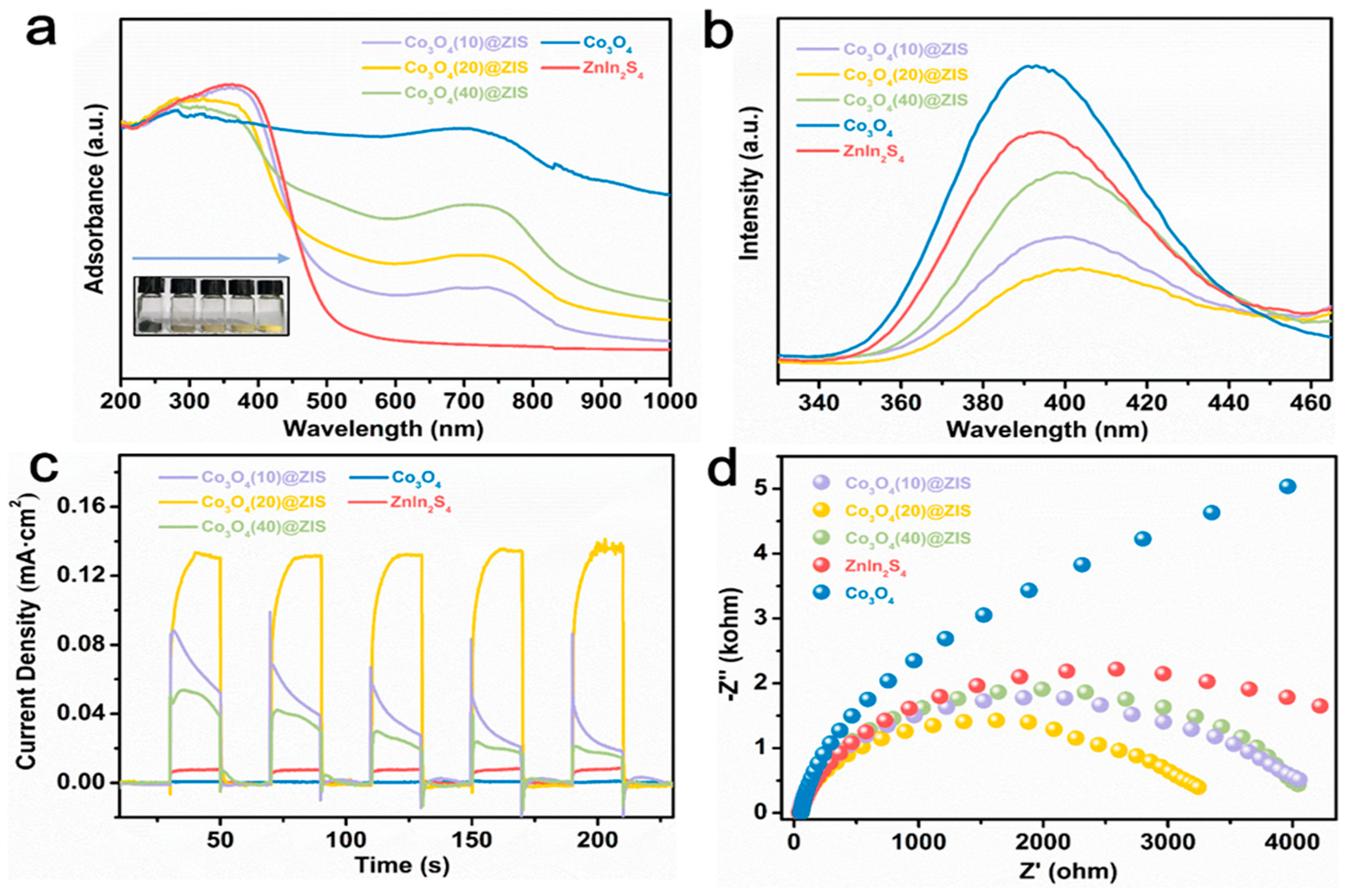
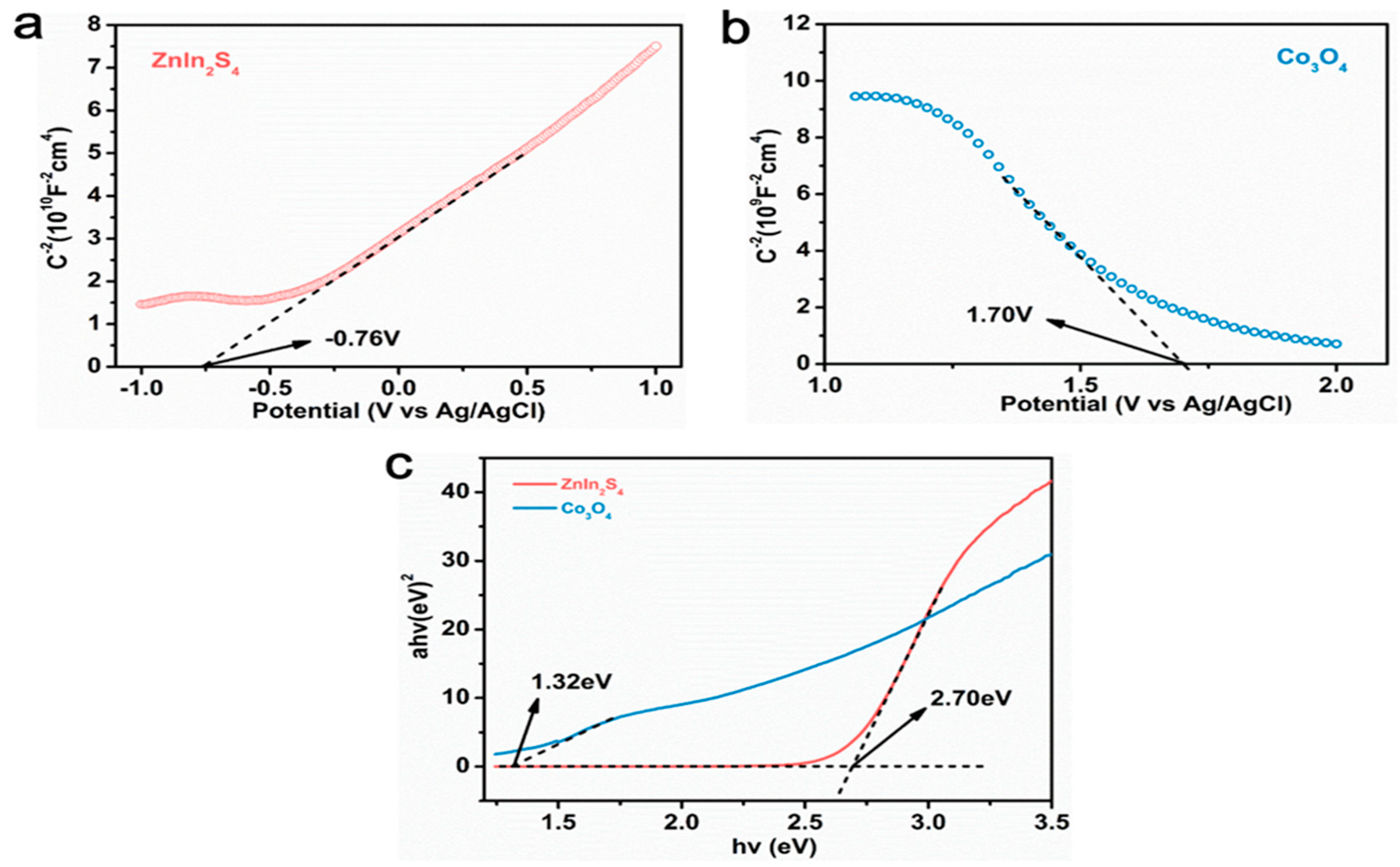
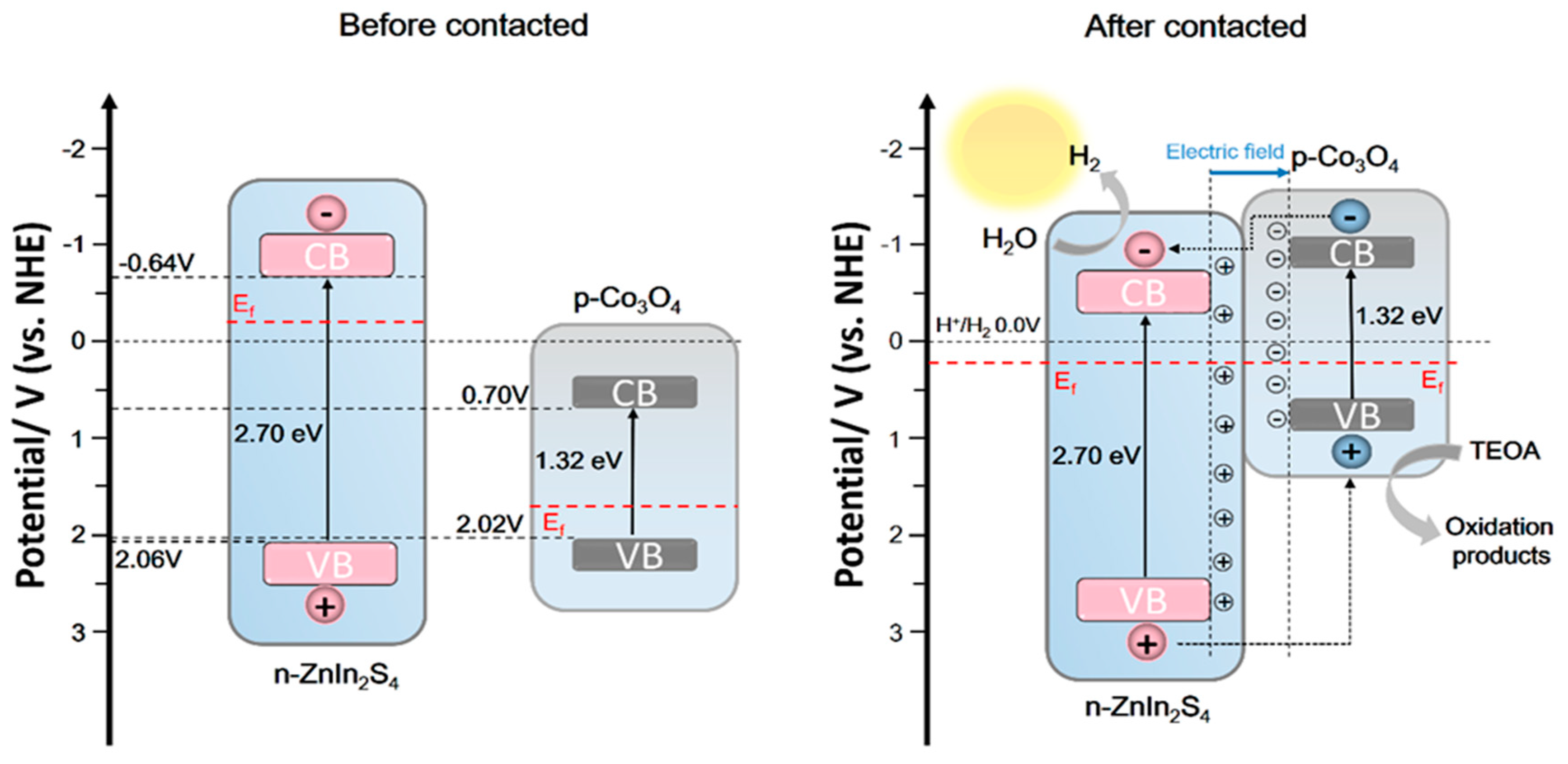
| Sample | SBET (m2 g−1 ) | Pore Volume (cm3 g−1 ) | Average Pore Size (nm) |
|---|---|---|---|
| Co3O4(20)@ZIS | 121 | 0.53 | 15.39 |
| ZnIn2S4 | 15 | 0.08 | 31.15 |
| Co3O4 | 71 | 0.35 | 19.03 |
Disclaimer/Publisher’s Note: The statements, opinions and data contained in all publications are solely those of the individual author(s) and contributor(s) and not of MDPI and/or the editor(s). MDPI and/or the editor(s) disclaim responsibility for any injury to people or property resulting from any ideas, methods, instructions or products referred to in the content. |
© 2023 by the authors. Licensee MDPI, Basel, Switzerland. This article is an open access article distributed under the terms and conditions of the Creative Commons Attribution (CC BY) license (https://creativecommons.org/licenses/by/4.0/).
Share and Cite
Xin, Z.; Zheng, H.; Hu, J. Construction of Hollow Co3O4@ZnIn2S4 p-n Heterojunctions for Highly Efficient Photocatalytic Hydrogen Production. Nanomaterials 2023, 13, 758. https://doi.org/10.3390/nano13040758
Xin Z, Zheng H, Hu J. Construction of Hollow Co3O4@ZnIn2S4 p-n Heterojunctions for Highly Efficient Photocatalytic Hydrogen Production. Nanomaterials. 2023; 13(4):758. https://doi.org/10.3390/nano13040758
Chicago/Turabian StyleXin, Zijian, Haizhao Zheng, and Juncheng Hu. 2023. "Construction of Hollow Co3O4@ZnIn2S4 p-n Heterojunctions for Highly Efficient Photocatalytic Hydrogen Production" Nanomaterials 13, no. 4: 758. https://doi.org/10.3390/nano13040758
APA StyleXin, Z., Zheng, H., & Hu, J. (2023). Construction of Hollow Co3O4@ZnIn2S4 p-n Heterojunctions for Highly Efficient Photocatalytic Hydrogen Production. Nanomaterials, 13(4), 758. https://doi.org/10.3390/nano13040758









